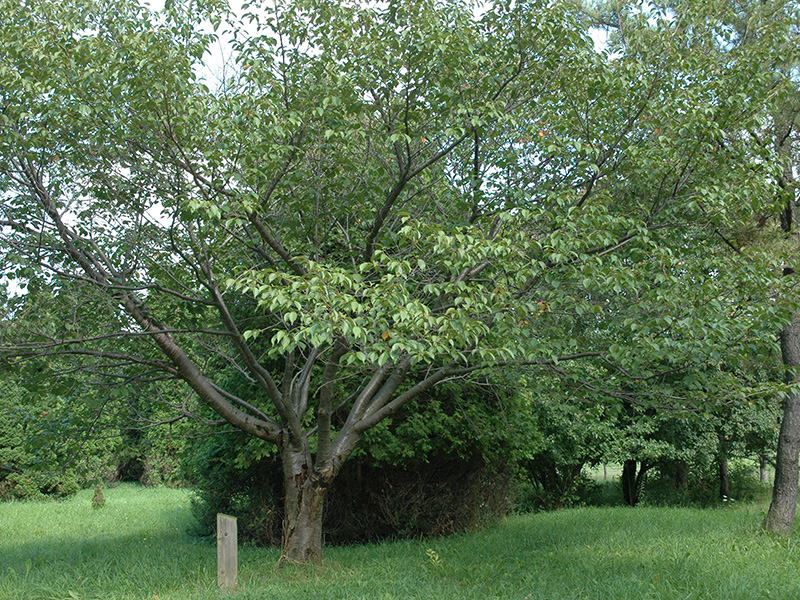| General Description | Early spring flower blooming woody tree. It has noticeably thin, glossy bark, attractive fruit, interesting autumn colours, and thin branches. Almost as wide as it is tall, it is suitable tree for shade in the landscape. |
| ID Characteristic | Early spring flowering before leaves emerge, interesting glossy brown bark with reddish coloured lenticels and the horizontal branch growth are all key identification characteristics. |
| Shape | Rounded, vase shaped. |
| Landscape | This is a specimen tree perfect for providing shade in an open sunny area. Compliments a water feature, deck or patio very nicely. Widely used along walkways or pathways since when it bloom the effect is quite stunning. |
| Propagation | Asexual propagation is the quickest and produces the best results: stem cuttings or budding done in mid-summer. Seeds require a two month cold period but germinate quite readily. |
| Cultivation | Plant in full sun and preferably in slightly acidic sand, clay, or loam soils that are well drained. P. xyedoensis has a low tolerance to road salt and is mildly tolerant of drought. Pruning needs to be done for clearance as the tree begins to droop with age and is often quite low branched so some maintenance is required to retain strong structured plant.. |
| Pests | Tent caterpillars, scales, spider mites, borers, aphids, verticillium wilt, ‘shot-holing’ and galls might be of concern however my experience in growing several trees over the last 20 years indicate that they are relatively problem free.
Plum Pox:
Symptoms may be confused with other diseases/disorders such as nutrient deficiencies or pesticide injuries. PPV symptoms can occur on leaves, flowers and/or fruit. Faint yellow rings or lines may be found on the leaves. PPV generally does not cause plant mortality however, can reduce the plant productivity and longevity.
How to Reduce the Spread and Impact of PPV:
1. Propagate vulnerable Prunus trees and shrubs outside of the affected area
a. Isolation is important to protect clean plants from future spread of the disease.
b. Propagating and growing vulnerable plants away from the virus-infected area reduce the likelihood of the disease spreading any further. This should be as far away from the quarantined area and any potential sources of the virus.
2. Propagate Prunus plants with virus-free Budwood and Rootstock from virus tested mother trees
a. This eliminates the propagation link for viral diseases.
3. Inspect vulnerable Prunus for symptoms
a. All Prunus shrubs and trees should be visually inspected for symptoms at lease twice per year and conducted by trained personnel familiar with the virus.
b. Any plants found to be infected should not be moved or sold and must be reported to the Canadian Food Inspection Agency immediately.
c. Inspections should not be conducted in periods of hot weather (temperatures over 30˚C).
4. Manage aphid vectors
a. Aphids are extremely attracted to suckers (vegetative shoots at the base of the tree), these should be removed to avoid aphid colonization, feeding or migration.
5. Plant tolerant and resistant varieties
a. When available, grow plum pox tolerant or resistant Prunus varieties.
|
| Notable Specimens | Washington D.C., United States of America, in the tidal basin area around the Lincoln and Washington Monuments. |
| Bark/Stem Description | Glossy, brown, thin bark with many visible horizontal lenticels showing inner bark that is a rust colour. |
| Leaf Description | Leaves are a bronze colour when young (emergence) but by summer turn a dark green. The leaf is simple, ovate to oval in shape with a serrate or double serrate leaf margin and measure 5-10 cm in length and 5 cm in width. Leaf arrangement is alternate and leaves have pinnate venation. |
| Flower Description | Very showy flowers produced before the leaves emerge in early spring, they are white or pale pink in colour. Blooms are typically about 3 cm in diameter and borne in clusters of 5-6 in a rounded shape umbel. |
| Fruit Description | A small 0.5-1 cm round, fleshy, black coloured, bitter tasting fruit. Fairly attractive looking but consumed by birds. |
| Colour Description | A wide variety of colours ranging from a bronze to bright green when the leaves are young, to a darker green once more developed. In autumn the leaves change from green to a reddish brown, then to yellow, and before they drop they turn a bright red. |



